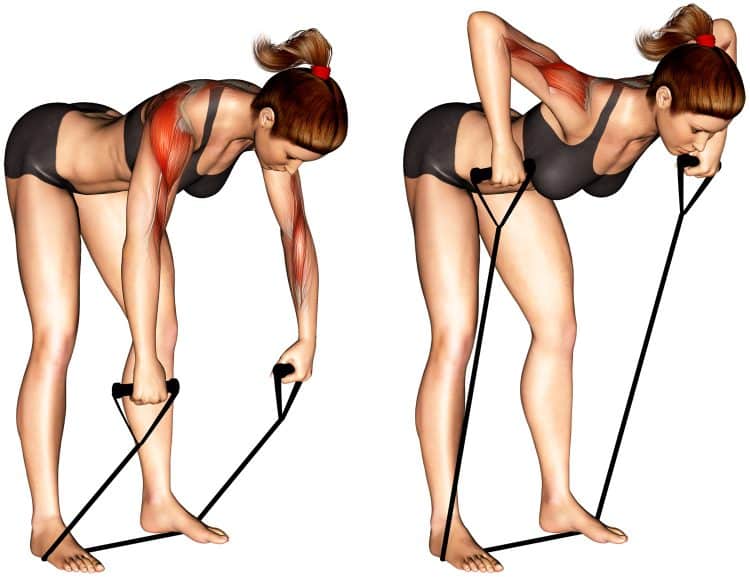Band rear delts rows, along with a fly variation, are the tried and true ways to build the rear-facing aspect of your shoulders at home without weights or any equipment (Other than your stretchy training tool). When resources are limited, we can’t think of a better method to strengthen your posture, tap into the upper back musculature, and provoke posterior gains, all for the price of less than a monthly gym membership. Do we have your attention now? Splendid!
Let’s take a deep dive into what a band rear delt row is, benefits and expectations, common mistakes you must avoid, and the variations and alternatives with unique advantages.
In This Exercise:
- Target muscle groups: Rear Deltoids
- Type: Strength and hypertrophy
- Mechanics: Isolation/compound
- Equipment: Resistance band
- Sets and reps: 2-4 x 6-20
Muscles Worked During Band Rear Delt Rows
While the name implies a deltoid-focused workout, and it is for the most part, make no mistake, you’re training so much more than that. Like the entire upper back anatomy, as well as the lower back, but to a lesser extent.
- Deltoid posterior – Did you know your shoulder has three primary elements that produce separate arm movements. Also called muscle heads (Not talking about those huge gym guys), you have front fibers that lift the arm forward, a side portion that lifts the arm up sideways, and one head on the back part of the arm that you can’t see, which moves the arm back behind you. Consequently, you need to train each portion according to its movement.
- Brachialis – Tucked partially behind the outer biceps, the brachialis is a mysterious muscle that shares space in the upper arm and forearm, where it bends the elbow. Brachialis is typically revealed in low body fat conditions, of which you can see how it contributes to upper arm width, although it can sometimes be difficult to differentiate from the biceps.
- Brachioradialis – The forearms have two primary muscle groups, flexors, and extensors. Brachioradialis anatomically belongs to the former, however, it’s fused with the brachialis, and its fibers work synergistically with brachialis, and the biceps to create arm flexion.
- Deltoid Lateral – Backward motions tend to activate the outer or middle head of your deltoids too. Typically, the lateral delts perform sideways arm action in a specific 15-100 degree motion, but there’s no way to keep them out of rear delt flys.
- Infraspinatus – Part of the rotator muscle group that stabilize the shoulder joint.
- Teres Minor – Also a rotator cuff muscle, teres minor is long, narrow, and attaches at the scapula and upper arm.
- Trapezius Lower Fibers – Thrown over the back like a “V” shaped hero’s cape, the trapezius are three parts, upper, middle and lower fibers that start from below the bony bump on the back of the head spread across the upper back, and come into a point, respectively. The lower traps pull the scapular muscles downward, and untuck the head from the neck.
- Trapezius Middle Fibers – A wide section of muscle, the trapezius middle helps the rear delts and other muscles set the scapula rearward into retraction. Another very important postural muscle.
How To Do The Band Rear Delt Row
Before you attempt band rear delt rows, go through the short checklist of step by step instructions provided for you below. Also check out the video demonstration, and scroll down to make sure you’re not making any of the common mistakes that can affect your gains.
Steps
- While holding your band with two hands, anchor it down with both feet in a roughly shoulder width stance to keep it anchored down, and minimize slack to maintain muscle tension throughout the full range of movement.
- Grab the handles or band, then bend your knees slightly, lean forward at the hips while keeping your back straight, and grab the band with a wider than shoulder width grip. Make sure the band is tight, and not relaxed when your arms are fully extended. You may need to make adjustments to your stance or grip to ensure there’s no slack in the band.
- While in a bent-over position, tense your core muscles, retract the shoulder blades partially, and pull the bands up to your lower chest. Squeeze to get a good contraction in the upper back.
- Straighten your arms toward the ground, then alternative between steps 3 and 4 until you’re satisfied with the number of repetitions.
Here’s a simple technique demonstration of band rear delt rows.
Level Up Your Fitness: Join our 💪 strong community in Fitness Volt Newsletter. Get daily inspiration, expert-backed workouts, nutrition tips, the latest in strength sports, and the support you need to reach your goals. Subscribe for free!
Benefits of Rear Delt Rows
So many reasons to make rear delt flys a consistent exercise in your posterior training regime.
Build powerful rear-facing delts
You should be equally concerned about the development of your rear as you are the frontside of your body. While it’s true your chest and abs are always in plain sight, ignore your rear and you’ll be fooling yourself. four sets of rows and pulls downs are not going to cut it. Spend as much time doing things like rear delts flys, facepulls, as you do chest flyes and front delt raises.
You’ll see a better physique, and so will others, especially since they can see what you usually can’t.
Better back gains
Lifting posture is crucial for core engagement, and consequently load transfer, spine and back health, and the integrity of your shoulders. Additionally, failing to maintain proper lifting form can cause compression of your nerves, arteries, and veins, also known as thoracic outlet syndrome.
Your rear delts are tasked with retracting the shoulder blades and keeping them in that position during strenuous lifting activities.
Unbreakable posture
There’s lifting posture, and then there’s everyday walking, sitting, and standing posture. The invention of smartphones and the newest greatest devices are stressing our necks more than ever and weakening our postural muscles. This often causes head pressure, aches, dizziness, stiff necks, fatigue, and possibly affects us neurologically too since the spine is so closely connected.
Safer alternative to free weights
Unless your band rolls up and hits you in the face, well, at least you won’t get your teeth knocked out like you could if rowing dumbbells to your neck area. We’re not saying it’s common but there is a safety factor with free weights.
Common Mistakes During Band Rear Delt Rows
While they may not be the end of the world, these common mistakes can affect your long term development, and performance. So try to avoid these bad training habits when performing band rear delt rows.
Releasing tension at the bottom
While some lifts involve dropping tension at the bottom of a rep, you now know it’s not the proper way to do band rear delt rows. This typically happens when there’s too much slack or looseness in the band because you haven’t pulled it tight before you started the exercise.
Well you may be losing out on some potential benefits as your muscles don’t get the opportunity to engage while fully lengthened, possibly shortchanging strength, and muscle building efforts.
Not challenging yourself in the bottom can also have mental disadvantages as it could throw off your focus, and create awkward movement, and asymmetrical technique when pulling.
Related: Time Under Tension – Does It Matter Or Just A Myth?
Not measuring your band
Much worse than having too much slack in your band is training with two sides of a different length. This is going to contribute to muscle, and consequently strength asymmetries which could lead to decreased performance, and possibly injuries when you do bilateral exercises with a barbell or machines that require both arms at once.
So, always take some time to visually compare (Not with an actual measuring tape or anything) both sides of your band from the floor to the starting position with your arms fully extended. Make sure the band is lengthened but not stretched for an accurate comparison.
Level Up Your Fitness: Join our 💪 strong community in Fitness Volt Newsletter. Get daily inspiration, expert-backed workouts, nutrition tips, the latest in strength sports, and the support you need to reach your goals. Subscribe for free!
Training too light
You won’t use as much weight compared to a standard heavy row, but the rear delts need heavy loads to grow and gain strength. While it’s okay to include high rep, moderate resistance sets, make sure to incorporate 6-10 rep sets where you take each set to failure.
9 Variations and Alternatives of Band Rear Delt Rows
Want to try some similar exercise variations using alternative training tools and positions? These are our favorite picks that replicate band rear delt rows.
Standing band rear delt row
This alternative is performed from an upright position, and not bent over like the primary example of this training guide. It may allow you to focus more on posture since you likely won’t be able to use the same weight loads. You want to pull your band higher than your nipples for optimal rear delt stimulation!
Use a hip width, or split leg (One foot in front of the other) stance to handle your loads.
Seated band rear delt row
Again and like the standing version, being seated simply gets you out of that bent over position which may be less comfortable for some people. You can sit on a bench which will take the legs out of the movement, or on the floor with your feet pressed up against something (Like the variation shown in the video demonstration below) for more support and increased resistance loading.
Seated band rear delt row steps
- Find a training rack, door, or something you can anchor your band to and press your feet up against. Then sit on the floor, attach your band to the object roughly mid chest height, and make sure your band is properly secured by pulling on it a few times, and inspecting your setup for safety.
- Keep your knees slightly bent with both feet braced against the anchor point, then extend your arms forward and grip your band in both hands. Make sure that when you sit straight up to perform the exercise, there’s resistance and no slack or looseness in the band before you start the set.
- Maintain a straight back, upright posture, and tight midsection.
- Now pull the band high to your upper chest, keeping the elbows level with the hands, and driving them behind your body. You should feel the contraction in your rear delts.
- Extend your arms forward to lengthen the muscles, then repeat steps 4 and 5 until you’ve completed the optimal reps.
Half kneeling band rear delt row
With one foot planted and the opposite knee on the floor, a half kneeling band rear delt fly is like a hybrid between sitting on the bench, or sitting down on the floor. The legs are less involved during standing, but more supportive than removing the legs entirely. You’ll probably also get more core engagement from trying to fight against the resistance.
Band pull-aparts
You only need your arms for band pull-aparts. It won’t challenge your body in the same way but this is a super focused variation that’s going to strengthen your postural muscles, fortify your shoulders, and increase shoulder mobility and stability.
One arm rear delt pulls
There’s one missing element in the other variations that this one offers, a deep rear delt stretch. You can’t replicate this with free weights and most machines.
Steps
- Anchor a single resistance band to an object higher than shoulder height.
- Now stand sideways to the object and grab the end of your band with the hand furthest away from it.
- Raise your arm to shoulder height, and take a few steps away from the anchor point until your arm is stretched across your body with your hand at the opposite shoulder.
- Keep your arm mostly extended, and use your rear delts to pull the band across your body in the opposite direction.
- Allow the band to stretch your arm cross body again, and repeat this exercise for the number of reps you choose.
Pro tip: Stand closer to the anchor base for less resistance or step further away to make the exercise harder.
Here’s a video demonstration by the late bodybuilder John “Mountain Dog” Meadows.
Free weight rear delt rows
In a gym setting, most people will choose barbells and dumbbells for rear delt rows. Free weights have one up on the band variation because the setup is faster, there’s no guessing your resistance, and the weight load remains consistent at every point of each repetition. Band training involved being more precise with your setup.
Cable rear delts rows
A bit similar, but superior in many ways other than accessibility for home exercisers, cable rear delt rows are more akin to a machine than bands. You see, cables don’t stretch. Therefore, the beginning of each rep is as challenging as the last part. You can also switch so so many different types of grips and attachments, which you can do with other training options.
Do the bent over option, or the classic seated cable row, where you have a foot platform which is more convenient than finding somewhere to prop your feet up against when using bands.
Band facepulls
An exercise that should be done quite often, in our opinion, facepulls gained notable attention especially in recent years for their posterior benefits. They’re very safe for the shoulders, will strengthen the rear delts, and upper back, and are a good habit for posture.
Able to be done vertically or horizontally, with the band anchored by your feet, or on an object above head height, choose which variation suits you. Bands are cables are the best tools for the job since you can do them standing straight up.
Related: 10 Best Facepull Alternatives: Exercises For Better Posture and Shoulder Health
Band rear delt flys
We also covered an entire guide on band rear delt flys. A more isolation geared exercise, it’s more of a mind-muscle connection exercise that opens up the arms, and possibly hits the posterior delts to a different extent than rows.
FAQ’s
How many sets and reps should I be doing for band rear delt rows?
At a minimum, we recommend 2 sets per workout for optimal stimulation, and anywhere between 6-20 reps, depending on your workout intensity, and goals.
Go heavier to build more strength, or do higher reps to failure for muscle gains.
Can I use any type of resistance band for rear delt rows?
The most common types of resistance bands will work great for this exercise, from the double handles bands to the looped style, or even therapy bands. Just make sure your bands are of good quality, and strong enough to support your efforts.
This is especially important for the more flimsy therapy type bands that can tear easily with too much force.
What's the difference between rear delt row vs. rear delt fly?
Rows allow you to lift more weight, and are therefore the superior option for building muscle strength. However, flys are an isolation exercise that may offer better focused muscle stimulation, and hence overall muscle gains too.
You can typically train with heavier loads in a rear row than a backwards fly because the load (Weight used) is closer to the point of effort (Shoulder muscles). Therefore, you have more of a mechanical advantage. Whereas with a fly, having extended arms creates a longer lever which requires more effort since the load is further away from the pivot point or the joint.
Both are very excellent movements to incorporate in your shoulder training routine.
Wrapping Up
If you’ve got a resistance band and full use of your arms and legs, then you can do band rear delt rows. An entry level variation, this is your simple answer to a stronger back, rear delts that pop, better posture, and more benefits. We also encourage you to try out some of the variations and alternate to keep your training interesting, which, in turn, produces more gains in the long term!
Start out light, make sure your shoulders are moving properly through the movement, and most importantly, you should feel the rear delts working. And don’t be afraid to challenge yourself with high resistance low rep sets, and we promise you’ll see a difference in your muscle development!
Interested in measuring your progress? Check out our strength standards for Face Pull, Seated Cable Row.









